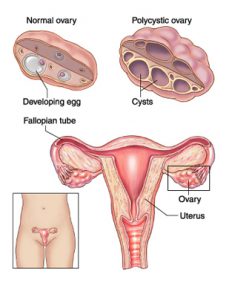Polycystic ovary syndrome
 Polycystic ovary syndrome (PCOS) is a common hormonal disorder among women of reproductive age. The name of the condition comes from the appearance of the ovaries in most, but not all, women with the disorder — enlarged and containing numerous small cysts located along the outer edge of each ovary (polycystic appearance).
Polycystic ovary syndrome (PCOS) is a common hormonal disorder among women of reproductive age. The name of the condition comes from the appearance of the ovaries in most, but not all, women with the disorder — enlarged and containing numerous small cysts located along the outer edge of each ovary (polycystic appearance).
Infrequent or prolonged menstrual periods, excess hair growth, acne and obesity can all occur in women with polycystic ovary syndrome. In adolescents, infrequent or absent menstruation may signal the condition. In women past adolescence, difficulty becoming pregnant or unexplained weight gain may be the first sign.
Polycystic ovary syndrome signs and symptoms often begin soon after a woman first begins having periods (menarche). In some cases, PCOS develops later on during the reproductive years, for instance, in response to substantial weight gain.
Menstrual abnormality:
This is the most common characteristic. Examples of menstrual abnormality include menstrual intervals longer than 35 days; fewer than eight menstrual cycles a year; failure to menstruate for four months or longer; and prolonged periods that may be scant or heavy.
Excess androgen:
Elevated levels of male hormones (androgens) may result in physical signs, such as excess facial and body hair (hirsutism), adult acne or severe adolescent acne, and male-pattern baldness (androgenic alopecia). However, the physical signs of androgen excess vary with ethnicity, so depending on your ethnic background you may or may not show signs of excess androgen. For instance, women of Northern European or Asian descent may not be affected.
Polycystic ovaries:
Enlarged ovaries containing numerous small cysts can be detected by ultrasound. Despite the condition’s name, polycystic ovaries alone do not confirm the diagnosis. To be diagnosed with PCOS, you must also have abnormal menstrual cycles or signs of androgen excess. Some women with polycystic ovaries may not have PCOS, while a few women with the condition have ovaries that appear normal.
Signs and symptoms vary from person to person, in both type and severity. To be diagnosed with the condition, your doctor looks for at least two of the following:
